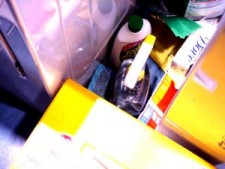 An article in today s Wall Street Journal exposes another reason for concern regarding keeping kids safe or at least safer, since 100 percent safety is only an ideal from harm via ingestion of common household products. In this case, the subject is those attractive, colorful and fragrant pods that are so convenient for dishwashers and washing machines.
An article in today s Wall Street Journal exposes another reason for concern regarding keeping kids safe or at least safer, since 100 percent safety is only an ideal from harm via ingestion of common household products. In this case, the subject is those attractive, colorful and fragrant pods that are so convenient for dishwashers and washing machines.
Entitled Laundry-Pod Poisonings Piling Up by Serena Ng, the article points out how this problem has skyrocketed in recent years, since the introduction of highly-concentrated laundry-detergent packets or pods:
At least seven people have died after biting into single-dose laundry packets, including four fatalities last year and one earlier this year, according to data reviewed by The Wall Street Journal. The deaths have raised the stakes for consumer product manufacturers such as Procter & Gamble Co. that have made detergent packets a centerpiece of their laundry strategy.
So far this year, accidental exposures involving children under six have been reported to U.S. poison centers at a rate of roughly 30 a day. While that is down from about 32 a day last year, poison-control experts are worried that the rate and severity of accidental exposures remains high three years after the product became widely available in the U.S. And the apparent risk isn t just with children. Laundry packets were a factor in two fatal accidents involving seniors with dementia who may have mistaken the multicolored capsules for candy.

There were over 11,700 such incidents reported to the American Association of Poison Control Centers in 2014, a 20 percent increase from 2013. This year s toll is on the same track as last year s. More than 90 percent have involved children under 6.
The solution to this problem is not so obvious. Manufacturers have made the packaging opaque, added child-resistant closures, and educational campaigns warning parents about proper storage. But they have resisted additional steps such as changing the composition of the product, or putting them in childproof containers. Naturally, some politicians have gotten into the fray: Sen. Durbin (D-IL) and Rep. Speier (D-CA) introduced the Detergent Poisoning and Child Safety Act, calling upon the Consumer Product Safety Commission to set rules requiring companies to tighten up their products safety.
ACSH s Dr. Gil Ross had this comment: This is truly a serious situation. It becomes even more disturbing when we contemplate the true extent of the problem. According to Dr. Brad Rodu s tobacco-related blog, in which he tried to put the alarmist fears about e-nicotine liquid poisonings in perspective, household products causing poisonings among children are a veritable epidemic of vast proportions: Here are some of the more common exposures (his information was obtained from the 2012 Annual Report of the American Association of Poison Control Centers National Poison Data System (NPDS): five-hundred eighty-one thousand incidents of exposures to household products, with 1,300 deaths.
| Non-pharmaceutical Exposure Cases Among Children Under 6 Years Old, 2012 | |
| Product Category | Number of Exposures |
| Cosmetics and personal care products | 156,623 |
| Household cleaners | 106,582 |
| Foreign bodies | 77,905 |
| Pesticides | 36,056 |
| Plants | 30,690 |
| Arts, crafts, office supplies | 21,146 |
| Deodorizers | 19,153 |
| Alcohols | 11,443 |
| Gasoline, other hydrocarbons | 10,572 |
| Food additives, spoilage | 10,547 |
| Bites, venom | 8,777 |
| Tobacco products | 7,480 |
| Essential Oils (clove, etc) | 7,446 |
| Paint, paint strippers | 7,192 |
| Adhesives, glue | 5,863 |
| Batteries | 5,116 |
| Chemicals | 3,923 |
| Fertilizers | 3,054 |
| Everything else | 51,351 |
| Total | 580,919 |
Obviously, there is nothing the government or even the manufacturers can do to stem this tide. The bottom line: parental responsibility is key. Parents have to be ever-vigilant. Of course, keeping dangerous products away from kids and having locked cabinets helps.


